25 ++ e coli shape bacilli or cocci 505468-What is the difference between cocci and bacilli
Example of Shape Bacteria Examples Coccus (plural cocci) round or ballshaped bacterium Staphylococcus aureus, agent of skin infection Bacillus (bacilli) rod or cylindrical shaped bacterium Bacillus cereus, agent of food poisoning Escherichia coli, agent of traveler's diarrhea, food poisoningGram Negative bacilliInclude bacteria such as Ecoli, salmonella, and shigella Cocci have a spherical shape while bacilli have a rod shape There are 3 more types of bacteria which are less commonAnaerobic grampositive cocci are recovered from about % of specimens of intraabdominal infections, such as peritonitis and abscesses of the liver, spleen, and abdomen 24 Generally, these organisms are recovered with other organisms of intestinal origin, including Escherichia coli, the Bacteroides fragilis group, and Clostridium spp
:max_bytes(150000):strip_icc()/MRSA-updated-5be08d0046e0fb005128794d.jpg)
3 Common Bacteria Shapes
What is the difference between cocci and bacilli
What is the difference between cocci and bacilli-Most of the bacteria range from 022 µm in diameter The length can range from 110 µm for filamentous or rodshaped bacteria The most wellknown bacteria E coli, their average size is ~15 µm in diameter and 26 µm in length In this figure The size comparison between our hair (~ 60 µm) and E coli (~1 µm) Notice how small theEscherichia coli are typically Gramnegative, rod shaped (–60 μm in length and 11–15 μm wide bacilli) bacteria with rounded ends The actual shape of these bacteria does, however, vary from spherical (cocci) cells through to elongated or filamentous rods



Gram Positive And Gram Negative Rods Microscopy Microbiology Microbiology Lab
Uploaded By JusticeButterflyPerson6901 Pages 25 This preview shows page 13 15 out of 25 pagesMoreover, the general term "bacillus" does not necessarily indicate the Grampositive staining common to class Bacilli For example, E coli is a rodshaped bacterium that can be described as "a bacillus", but it stains Gramnegative and does not belong to the genus Bacillus or the class BacilliE coli , a large, varied group of bacteria, are found in the environment, intestines and food of humans and animals While most E coli strains are harmless, others can cause diarrhea, urinary tract infections, pneumonia and respiratory illness Bacillus subtilis are pervasive bacteria commonly found in areas of air, soil and water that are not toxic or pathogenic to the environment, and as
The bacillus shape can appear as a single bacillus, a streptobacillus, or a coccobacillus The spiral shape can appear in several forms vibrio, spirillum, and spirochete The metric unit micrometer (1/1,000,000 or 10 6 of a meter) is used to measure bacterial sizeGrampositive cocci and Gramnegative bacilli Microscopic appearance Cocci in grapelike clusters (Saureus) and bacilli(Ecoli) Clinical significance of Saureus Frequently found as part of the normal skin flora on the skin and nasal passages;The microorganisms isolated and identified were Proteus spp, Esherichia coli, Bacillus spp, Staphylococcus aureus, Legionella spp, Enterobacterspp and Micrococcus spp The Bacillus spp (rod shaped), Staphylococcus aureus (cocci in clusters) and Micrococcus spp (cocci in pairs) turned to be gram positive and nonmotile, having Bacillus spp a
E coli , a large, varied group of bacteria, are found in the environment, intestines and food of humans and animals While most E coli strains are harmless, others can cause diarrhea, urinary tract infections, pneumonia and respiratory illness Bacillus subtilis are pervasive bacteria commonly found in areas of air, soil and water that are not toxic or pathogenic to the environment, and asThey are defined as rodshaped Gramnegative organisms which ferment lactose with the production of acid and gas when incubated at 35 °C I Tarcísio Brito, the infinite life in the Land, where all the species also the man have certainly ancestral origin, where the pursuing of the life (for the future) results in an arrival to the past of Daily payHistory;Their rigid cell wall gives them their shape An example of cocci is Staphylococcus hominis, and it occurs commonly on human and animal skin harmlessly, but it may occasionally cause infection in patients with weak immune systems An example of bacilli is Escherichia coli, and these live in the intestines of animals and decompose undigested
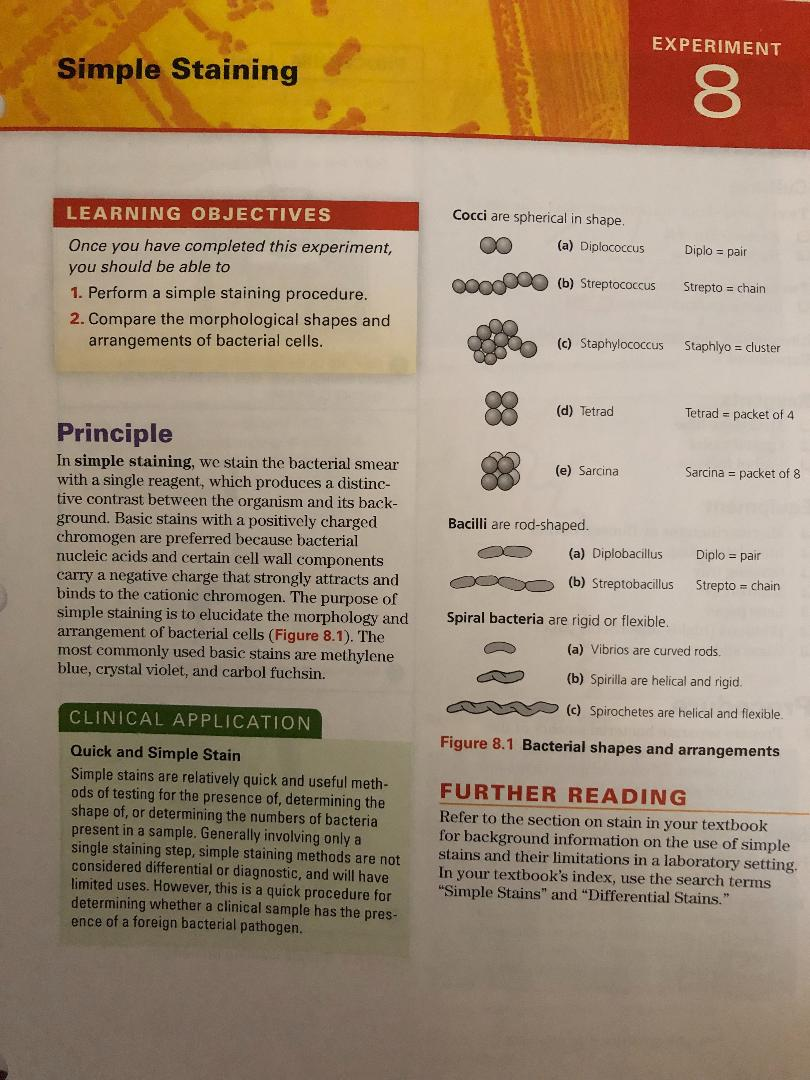


Solved I Attached Lab Report And Lab Pictures B Cereus C Chegg Com



Bacteria Overview Amboss
D Using the internet, find information about the following bacteria Insert an unlabeled photograph of a microscope slide (not a line drawing) of each bacterium (include where you copied the picture from, ie the web site), identify the shape (cocci, bacilli, or spirilla) and describe the diseases they causeEscherichia coli are typically Gramnegative, rod shaped (–60 μm in length and 11–15 μm wide bacilli) bacteria with rounded ends The actual shape of these bacteria does, however, vary from spherical (cocci) cells through to elongated or filamentous rodsCocci (sphereshaped) Gram positive cocci Grape‑like arrangements (Staphylococcus) Chain‑like arrangements (Streptococcus, Enterococcus) Gram negative cocci diplococcus (eg, Neisseria, Moraxella) Bacilli (rodshaped) Gram positive bacilli (eg, Clostridium, Listeria) Gram negative bacilli Eg, Legionella pneumophila, Helicobacter



Shape Of Bacterial Cell Cocci Bacilli Spirilla Bacteria Stock Photo Download Image Now Istock



Solved 1 Identify The Morphology Morphological Arrangem Chegg Com
Grampositive bacteria are bacteria with thick cell walls In a Gram stain test, these organisms yield a positive result Here's why knowing whether the result is positive or negative is importantBiology Of E Coli E coli (Escherichia coli) are a small, Gramnegative species of bacteriaMost strains of E coli are rodshaped and measure about μm long and 0210 μm in diameterThey typically have a cell volume of 0607 μm, most of which is filled by the cytoplasm Since it is a prokaryote, E coli don't have nuclei;Bacilli bacteria are among the first bacteria to have arisen, and this shape is said to be not as advantageous as other shapes This has been assumed upon the observation of the behavior of filamentous E coli cells which, though motile and chemotactic, move slowly and cannot tumble to change direction
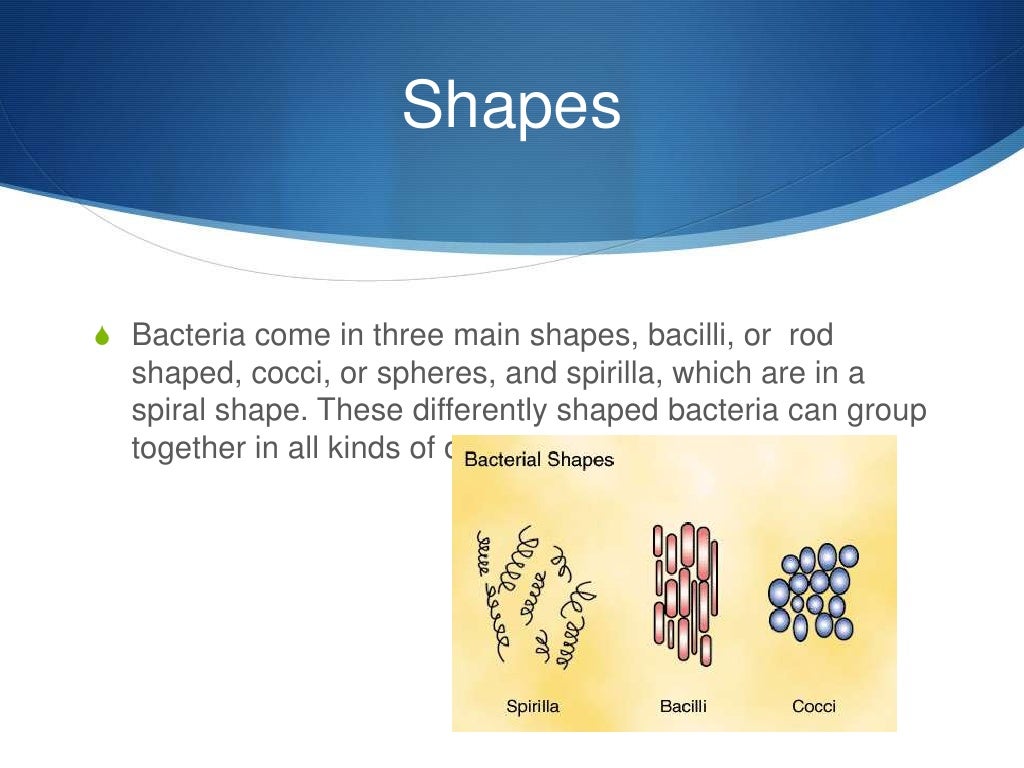


E Coli



Bacteria Cocci Bacilli Spirilla Biology Notes Infection Control Principles
Bacilli bacteria are among the first bacteria to have arisen, and this shape is said to be not as advantageous as other shapes This has been assumed upon the observation of the behavior of filamentous E coli cells which, though motile and chemotactic, move slowly and cannot tumble to change directionIe the numbers and patterns in which they occur While some cocci cause diseases in humans and animals, some are usefulE coli bacteria are a normal part of the intestinal flora in humans and other animals, where they aid digestion They are examples of bacilli shaped bacteria PASIEKA/Science Photo Library/Getty Images Bacillus Cell Arrangements Bacillus is one of the three primary shapes of bacteria Bacillus (bacilli plural) bacteria have rodshaped cells



Gram Positive Bacteria Microbiology



Coccus Transparent Background Png Cliparts Free Download Hiclipart
Difference Between Cocci and Bacilli Shape Cocci Cocci are either spherical, oval, bean or kidneyshaped Bacilli Bacilli are either rod, vibrio, filamentous, spirochetes, spindle or spirillumshaped Symmetry Cocci One axis of the bacterium is almost the same as the other Bacilli One axis of the bacterium is longer than the other Bacillus is mostly arranged as single bacteria in bacillusIt is estimated that % of the human population are longterm carriers of S aureusExamples of bacilli include Bacillus anthracis, the bacterium that causes anthrax, and the well known E coli This shape of bacteria can also form long chains called streptobacillus Another form is called coccobacillus, which describes a class of bacteria whose shape is somewhere between that of the coccus and the bacillus



Classification On The Basis Of Shape All



The Selective Value Of Bacterial Shape Microbiology And Molecular Biology Reviews
Bacilli Bacteria Bacilli are rodshaped bacteria, which can be found both in solitary states or arranged together Bacilli are capable of producing endospores in the presence of air—in fact;Examples of bacilli include Bacillus anthracis, the bacterium that causes anthrax, and the well known E coli This shape of bacteria can also form long chains called streptobacillus Another form is called coccobacillus, which describes a class of bacteria whose shape is somewhere between that of the coccus and the bacillus1 There are three basic shapes of bacteria coccus, bacillus, and spiral 2 Based on planes of division, the coccus shape can appear in several distinct arrangements diplococcus, streptococcus, tetrad, sarcina, and staphylococcus 3 The bacillus shape can appear as a single bacillus, a streptobacillus, or a coccobacillus 4


Biol 230 Lecture Guide Gram Stain Of A Mixture Of Gram Positive And Gram Negative Bacteria



Observing Bacteria Under The Microscope Gram Stain Steps Rs Science
Difference Between Cocci and Bacilli Shape Cocci Cocci are either spherical, oval, bean or kidneyshaped Bacilli Bacilli are either rod, vibrio, filamentous, spirochetes, spindle or spirillumshaped Symmetry Cocci One axis of the bacterium is almost the same as the other Bacilli One axis of the bacterium is longer than the other Bacillus is mostly arranged as single bacteria in bacillusFor rodshaped or filamentous bacteria, length is 110 µm and diameter is 0251 0 µm E coli , a bacillus of about average size is 11 to 15 µm wide by to 60 µm long Spirochaetes occasionally reach 500 µm in length and the cyanobacterium Oscillatoria is about 7 µm in diameterD Using the internet, find information about the following bacteria Insert an unlabeled photograph of a microscope slide (not a line drawing) of each bacterium (include where you copied the picture from, ie the web site), identify the shape (cocci, bacilli, or spirilla) and describe the diseases they cause



Shape Of Bacterial Cell Cocci Bacilli Spirilla Bacteria Stock Photo Download Image Now Istock


Basic Bacterial Identification Microbiology Teaching Resource Microbiology Nuts Bolts
Course Title PHA 4107;Example of Shape Bacteria Examples Coccus (plural cocci) round or ballshaped bacterium Staphylococcus aureus, agent of skin infection Bacillus (bacilli) rod or cylindrical shaped bacterium Bacillus cereus, agent of food poisoning Escherichia coli, agent of traveler's diarrhea, food poisoningBacteria classification Cocci sphericalovoid in shape Bacilli cylindrical in Bacteria classification cocci sphericalovoid in shape School University of Ottawa;



Observing Bacteria Under The Microscope Gram Stain Steps Rs Science



Escherichia Coli Wikipedia
E coli , a large, varied group of bacteria, are found in the environment, intestines and food of humans and animals While most E coli strains are harmless, others can cause diarrhea, urinary tract infections, pneumonia and respiratory illness Bacillus subtilis are pervasive bacteria commonly found in areas of air, soil and water that are not toxic or pathogenic to the environment, and as1 There are three basic shapes of bacteria coccus, bacillus, and spiral 2 Based on planes of division, the coccus shape can appear in several distinct arrangements diplococcus, streptococcus, tetrad, sarcina, and staphylococcus 3 The bacillus shape can appear as a single bacillus, a streptobacillus, or a coccobacillus 4Bacteria commonly take on one of three shapes bacilli, cocci, and spirilla Bacilli have a rod shape, cocci have a spherical shape, and spirilla have a spiral or wave shape Their shape was often used as a classification system until recently Bacteria may stay linked after division, forming other shapes such as clusters, filaments, and tight
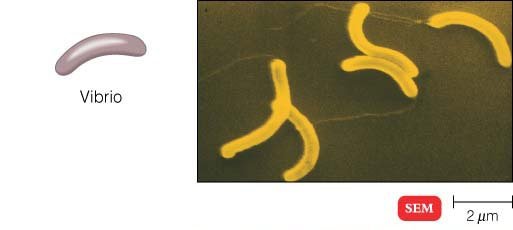


Different Size Shape And Arrangement Of Bacterial Cells



Gram Positive And Gram Negative Rods Microscopy Microbiology Microbiology Lab
Escherichia coli Escherichia coli (Ecoli) is a common gramnegative bacterial species that is often one of the first ones to be observed by students Most strains of Ecoli are harmless to humans, but some are pathogens and are responsible for gastrointestinal infections They are a bacillus shaped bacteria that has a very fast growth (theyInstead, their genetic material floats uncoveredInstead, their genetic material floats uncovered



Solved 1 Identify The Morphology Morphological Arrangem Chegg Com
:max_bytes(150000):strip_icc()/vibrio_cholerae-56a09b3c5f9b58eba4b204d8.jpg)


3 Common Bacteria Shapes
E that finishes in return to theMorphological features, such as size & shape of various microbes Size large or small cocci long or short rods/bacilli Staph cocci in clusters E coli rods, no arrangementGrampositive bacteria are bacteria with thick cell walls In a Gram stain test, these organisms yield a positive result Here's why knowing whether the result is positive or negative is important



Different Size Shape And Arrangement Of Bacterial Cells



Bacteria Definition Types Infections Live Science
Rob/bacillus shaped – Escherichia coli Coccobacillus – which is a combination of both cocci and bacilli shapes include Hemophilus influenza Streptobacillus are rodshapes that are connected together in chains eg Streptobacillus moniliformisIn shape, they may principally be Rods (bacilli), Spheres (cocci), and Spirals (spirillum) Size of Bacterial Cell The average diameter of spherical bacteria is 05 µm For rodshaped or filamentous bacteria, the length is 110 µm and the diameter is 0251 0 µmThe length can range from 110 µm for filamentous or rodshaped bacteria The most wellknown bacteria E coli, their average size is ~15 µm in diameter and 26 µm in length In this figure The size comparison between our hair (~ 60 µm) and E coli (~1 µm) Notice how small the bacteria are



Bacteria Cocci Hd Stock Images Shutterstock



Bacilli Wikipedia
Biology Of E Coli E coli (Escherichia coli) are a small, Gramnegative species of bacteriaMost strains of E coli are rodshaped and measure about μm long and 0210 μm in diameterThey typically have a cell volume of 0607 μm, most of which is filled by the cytoplasm Since it is a prokaryote, E coli don't have nuclei;Cocci and bacilli are the most common ones These groups are described below Cocci These are oval or spherical shaped bacteria (Figure 2) They are arranged in diverse ways Cocci can be classified on the basis of arrangement Diplococcus coccus in pairs Eg, Neissseria gonorrhoae, PneumococcusStreptobacilli Bacilli arranged in chains Coccobacillus Oval and similar to coccus (circular shaped bacterium) There is no connection between the shape of a bacterium and its color in the Gram staining MacConkey agar can be used to distinguish among Gram negative bacilli such as E coli and salmonella Grampositive examples Actinomyces



Morphology Culture Characteristics Of Escherichia Coli E Coli



Cocci Bacteria High Resolution Stock Photography And Images Alamy
Bacteria Examples Coccus (plural cocci) round or ballshaped bacterium Staphylococcus aureus, agent of skin infection Bacillus (bacilli) rod or cylindrical shaped bacterium Bacillus cereus, agent of food poisoning Escherichia coli, agent of traveler's diarrhea, food poisoningIt is a type of bacteria characterized by oval or rod shape It comes from the words "cocci" and "bacilli" Cocci are bacteria with a sphere shape while the bacilli are bacteria with a rod shape If the bacteria have these two shapes, then they are called coccobacilli There are different species of coccobacilliThe microorganisms isolated and identified were Proteus spp, Esherichia coli, Bacillus spp, Staphylococcus aureus, Legionella spp, Enterobacterspp and Micrococcus spp The Bacillus spp (rod shaped), Staphylococcus aureus (cocci in clusters) and Micrococcus spp (cocci in pairs) turned to be gram positive and nonmotile, having Bacillus spp a



Methods Of Classifying And Identifying Microorganisms Boundless Microbiology


Staphylococcus Aureus And Ecoli Under Microscope Microscopy Of Gram Positive Cocci And Gram Negative Bacilli Morphology And Microscopic Appearance Of Staphylococcus Aureus And E Coli S Aureus Gram Stain And Colony Morphology On Agar Clinical
E coli is described as a Gramnegative bacterium This is because they stain negative using the Gram stain The Gram stain is a differential technique that is commonly used for the purposes of classifying bacteriaIt is a type of bacteria characterized by oval or rod shape It comes from the words "cocci" and "bacilli" Cocci are bacteria with a sphere shape while the bacilli are bacteria with a rod shape If the bacteria have these two shapes, then they are called coccobacilli There are different species of coccobacilliCocci are one of the two basic bacterial forms, the other being bacillus This classification, as you know, is based on their shape Cocci are further classified on the basis of their aggregations;



Gram Staining Rules
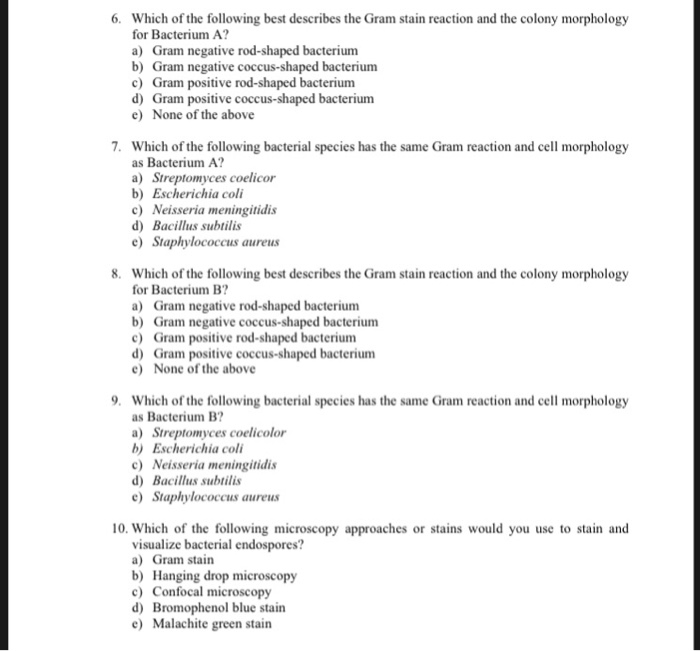


Solved 6 Which Of The Following Best Describes The Gram Chegg Com
Escherichia coli Escherichia coli (Ecoli) is a common gramnegative bacterial species that is often one of the first ones to be observed by students Most strains of Ecoli are harmless to humans, but some are pathogens and are responsible for gastrointestinal infections They are a bacillus shaped bacteria that has a very fast growth (theyShape Cocci Bacilli Cocci Arrangement Grapelike clusters Isolated Grapelike clusters Results Both cells were stained blue due to the primary staining caused by Loeffler's methylene blue Gram positive bacteria Conclusion and Discussion In the monochrome staining of S epidermidis and E coli, both the bacteria cells were stained blue in colourSome bacilli can only grow in the presence of air Escherichia coli—better known as E coli—is a type of bacilli that many are familiar with



Coccus Wikipedia



Bacteria
Escherichia coli (/ ˌɛʃəˈrɪkiə ˈkoʊlaɪ /), also known as E coli (/ ˌiː ˈkoʊlaɪ /), is a Gramnegative, facultative anaerobic, rodshaped, coliform bacterium of the genus Escherichia that is commonly found in the lower intestine of warmblooded organisms (endotherms)



Bacterial Characteristics Gram Staining Video Khan Academy


Q Tbn And9gctuaembtt8qjt9nhqkdg 2aygbfyj0rgbbbl Gh8arl7lbnku 5 Usqp Cau



Bacteria Diversity Of Structure Of Bacteria Britannica


E Coli Gram Stain Introduction Principle Procedure And Result Interpret


Difference Between Cocci And Bacilli Knowswhy Com



Observing Bacteria Under The Microscope Gram Stain Steps Rs Science



Different Size Shape And Arrangement Of Bacterial Cells



Surface Area To Volume Ratio A Natural Variable For Bacterial Morphogenesis Trends In Microbiology
:max_bytes(150000):strip_icc()/MRSA-updated-5be08d0046e0fb005128794d.jpg)


3 Common Bacteria Shapes



Solved Shape Of E Coli Cocci Bacilli Vibrio Spirallum Hy Chegg Com



Escherichia Coli E Coli An Overview Microbe Notes


Colony Characteristics Of E Coli Sciencing



Identification Of Unknown Bacteria Microbiology Laboratory Exercise



Cocci Bacteria High Resolution Stock Photography And Images Alamy


Stock Image Illustration Of Diverse Fecal Bacteria Within The Colon The Bacteria Include Long Gram Negative Rod Shaped Bacilli Such As Bacteroides And Escherichia Coli Gram Positive Cocci Such As Enterococcus And Gram Negative Spiral Bacteria



Morphology Of Bacteria Bacteriology Microbe Notes



Classification Of Bacteria Based On The Shape Cocci Bacilli Vibrio Spirilla Spirochaete Tamil Youtube



Contrasting Mechanisms Of Growth In Two Model Rod Shaped Bacteria Nature Communications



Pin On Biology



Bacterial Sizes Shapes And Arrangement With Examples


Bacillus Shape Wikipedia



Mrcp Revision On The Go Mrcp Revision Battle 46 1 Classification Of Bacteria



Solved Create A Dichotomous Key For The Identification Of Chegg Com



Cocci Or Cocus Bacteria Structure Types And Examples


Staphylococcus Aureus And Ecoli Under Microscope Microscopy Of Gram Positive Cocci And Gram Negative Bacilli Morphology And Microscopic Appearance Of Staphylococcus Aureus And E Coli S Aureus Gram Stain And Colony Morphology On Agar Clinical



Solved I Need To Complete This I Posted 3 Pictures I Chegg Com



Different Size Shape And Arrangement Of Bacterial Cells



Different Size Shape And Arrangement Of Bacterial Cells
:max_bytes(150000):strip_icc()/e.coli_updated-5be08d8fc9e77c005139d286.jpg)


3 Common Bacteria Shapes



Different Size Shape And Arrangement Of Bacterial Cells



E Coli


Staphylococcus Aureus And Ecoli Under Microscope Microscopy Of Gram Positive Cocci And Gram Negative Bacilli Morphology And Microscopic Appearance Of Staphylococcus Aureus And E Coli S Aureus Gram Stain And Colony Morphology On Agar Clinical



Mixed Culture 1 1 Of M Luteus Gram Positive Cocci And E Coli Download Scientific Diagram



Gram Positive And Gram Negative Bacteria Coccus Bacillus Curved Bacteria In Petri Dish Stock Photo Image By C Airen Creation



L Form Bacteria Wikipedia



52 Microbiology Unknown Project Cscc Bio 2215 Ideas Microbiology Medical Laboratory Medical Laboratory Science


Small Things Considered On Shape



Pin On Microbiology



Gram Negative Organisms Pm2 Pathophysiology Gram Negative Cocci Neisseria Gonorrheae Neisseria Meningitidis Gram Negative Bacilli Escherichia Coli Salmonella Ppt Download



Shape Of Bacterial Cell Cocci Bacilli Spirilla Bacteria Background High Res Stock Photo Getty Images


Small Things Considered On Shape



Bacterial Sizes Shapes And Arrangement With Examples



Pin On Microcosmos



E Coli Under The Microscope Types Techniques Gram Stain Hanging Drop Method
/bacteria_shapes-updated-5be08caf4cedfd0026957870.jpg)


3 Common Bacteria Shapes



2 1 Sizes Shapes And Arrangements Of Bacteria Biology Libretexts



Why Is It Important To Know The Shape And Arrangement Of Bacteria Quora


Q Tbn And9gcrxsv6valktvydnaiqm6 Yoim4dbn 9td0atqk2azvfczn73wcq Usqp Cau


1



Morphology Culture Characteristics Of Escherichia Coli E Coli
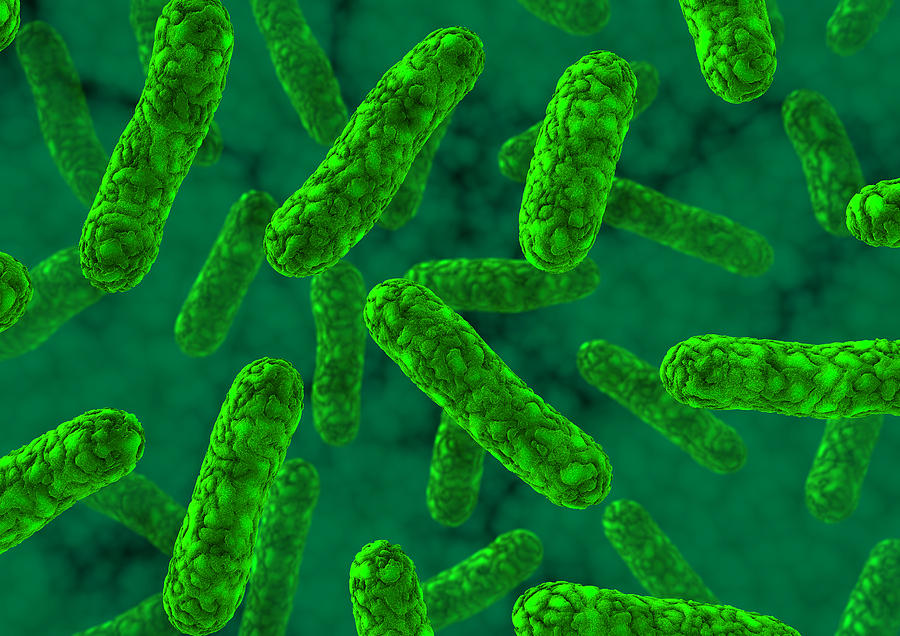


Rod Shaped Bacteria Photograph By David Mack
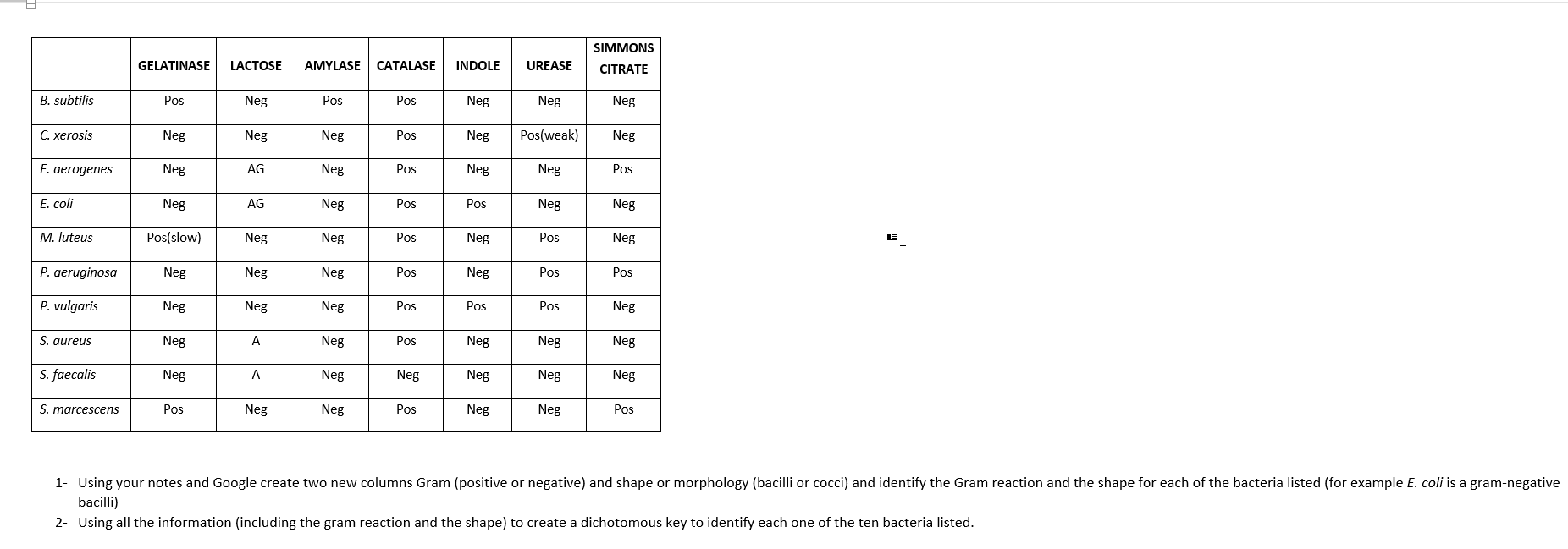


Solved 1 Using Your Notes And Google Create Two New Colu Chegg Com



Shape Of Bacterial Cell Cocci Bacilli Spirilla Bacteria Stock Photo Download Image Now Istock



Solved Which Bacteria Have The Shapes Coccus Bacillus S Chegg Com



Gut Microbiota Wikipedia



Gram Negative Bacteria Cell Wall Examples Diseases Antibiotics



General Bacteriology Bacterial Cell Morphology Staining



Bacterial Cell Morphology And Classification Definition Shapes Arrangements Microbiology Class Video Study Com



Bacteria 101 Cell Walls Gram Staining Common Pathogens Tusom Pharmwiki



Shape Of Bacterial Cell Cocci Bacilli Spirilla Bacteria Stock Photo Download Image Now Istock



Bacteria Definition Types Examples



Bacteria Whose Cell Has Only A Curve Comma Is



Solved Discussion 30 Points General Discussion Restate Y Chegg Com



Shutterstock Puzzlepix



Bacteria Exercise Flashcards Quizlet


Gram Negative Bacteria Microbiology Medbullets Step 1



Gram Negative Bacteria Pathogen Profile Dictionary



Cocci Bacteria Images Stock Photos Vectors Shutterstock



Bacteria Shape High Res Stock Images Shutterstock



Bacteria Bacilli Spirilla And Cocci Schoolworkhelper



Gram Negative Bacteria Wikipedia


コメント
コメントを投稿